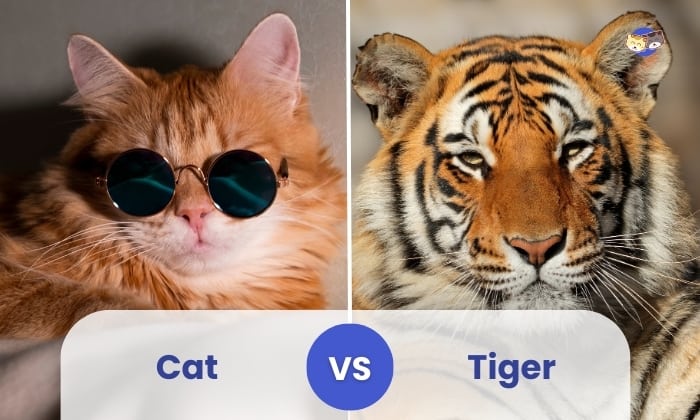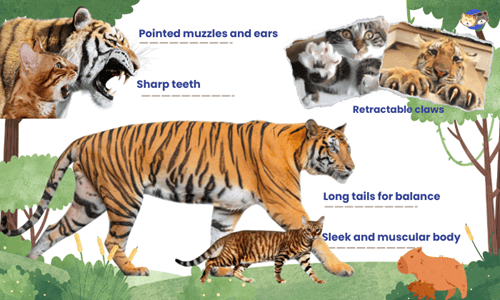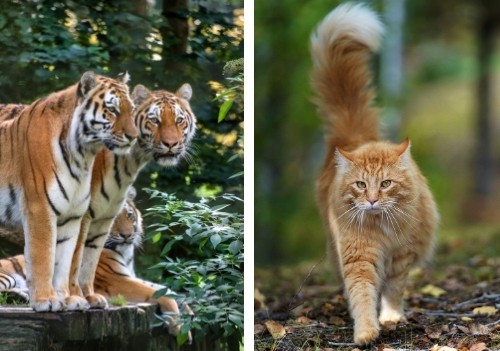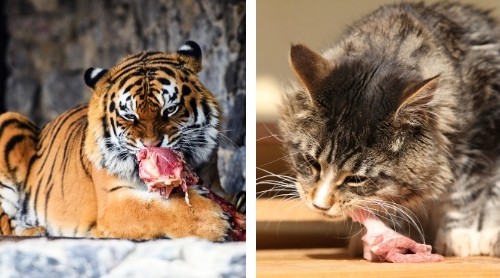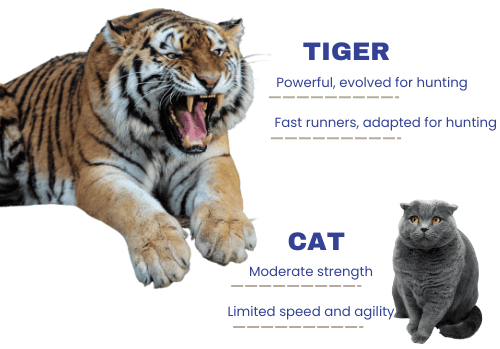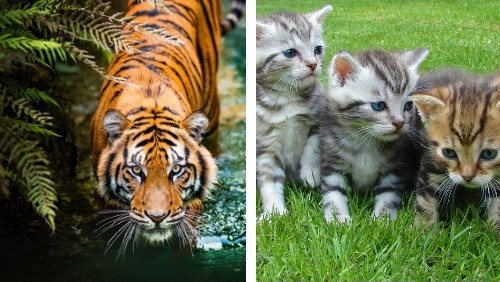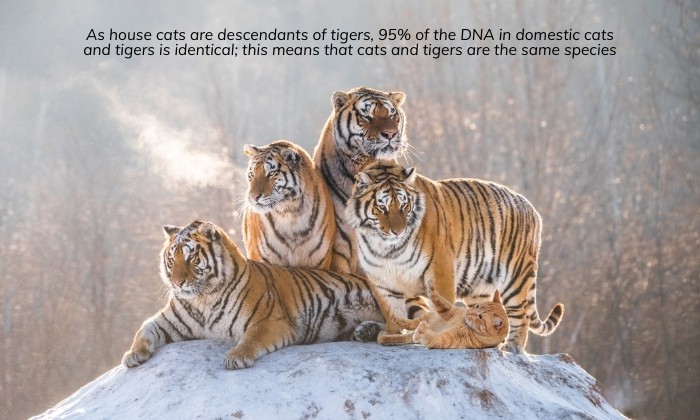Tigers are very similar to our household cats – except they’re a lot larger, wilder, and undomesticated. This is not surprising since both furry animals come from the feline family.
But you might be wondering – how exactly are cats and tigers similar? How do they differ?
This article will compare cats vs. tigers. We will also discuss everything you need to know about these two felines, so read until the end!
| Cat | Tiger | |
| Body Length (Adult) | 18 inches | 11 feet |
| Body Weight (Adult) | 8 – 12 pounds | 370 to 580 pounds |
| Strength | Leaner and weaker | Stronger and more muscular |
| Coat Pattern | Varies from solid pattern to tricolor coat | Bicolor |
Table of Contents
Similarities Between Cats and Tigers
Cats and tigers share some similarities because they come from the same feline ancestry. Here are some notable similarities between these animals:
1. Physical Resemblance
The most notable resemblance between cats and tigers is the identical shape of their faces and bodies. They have the same pointed muzzles and ears, making cats appear like miniature tigers.
These felines also have a similar body shape—sleek and muscular, with long tails that they use to balance themselves when leaping.
Cats and tigers also both have retractable claws and sharp teeth.
2. Marking Territories
If you’re a cat owner, you’ve probably seen your pet rubbing its body onto objects. This is their way of marking their territories.
Like cats, tigers have the same behavior, which is especially useful since they live in the wild. This habit helps to warn other animals about its presence.
3. Both are Carnivores
House cats are descendants of wild felines. So, just like tigers, they feed on meat as a primary diet.
Both cats and tigers also have hunting instincts. Cats look for small animals like birds and mice for food, while tigers hunt larger animals like deer to satiate their hunger.
But since most domesticated cats are pets, they feed on commercial cat food made of meat to meet their nutritional needs. Meanwhile, hunting is and will remain a tiger’s instinct because they live in the wild.
4. They are Territorial
Cats and tigers both like living alone. The main reason for this behavior is their territorial nature. The only time you will see tigers with another one of their kind is once they find a mate.
While you can get a cat to familiarize itself with you and other house pets, chances are that the cat can still get aggressive if you violate their “territory.” For example, u/Bienheureux shared her experience with her cat:
Differences Between Tiger vs Cat
1. Size
The body length and weight of house cats and tigers greatly vary. Domestic cats usually only measure 18 inches in length, while tigers can reach up to 11 feet long.
Tigers are also up to a hundred times heavier than cats. Most adult household cats only weigh around 8 to 12 pounds.
On the other hand, tigers reach up to 580 pounds when they reach adulthood, with the average range being 370 to 550 pounds.
2. Strength
Tigers live in the wild, so their bodies evolved into something that can tackle other large wild animals. Meanwhile, people take care of domesticated cats, so they don’t need a lot of strength to survive.
The fact that tigers are a lot stronger than cats is obvious. The reason is that they have muscular legs that allow them to run fast.
A domestic cat’s body is leaner than a tiger’s. Its claws, although sharp, are smaller than a tiger’s claws. As a result, they can do less damage to the prey they catch.
3. Coat Pattern
Domesticated cats feature various fur colors and patterns. There are solid-colored, bicolor, tabby, tuxedo, and calico cats.
There are even house cats with a stripped fur pattern similar to tigers or those with no hair at all.
On the other hand, tigers only showcase a single pattern. They are bicolor, particularly reddish-orange, with stripes of black.
But although very rare, there are albino tigers with a combination of white and black.
Are House Cats Related to Tigers?
Every cat, whether domesticated or wild, belongs to the Felidae family. This means that domesticated cats are related to tigers. In fact, researchers discovered that about 95 percent of a cat and tiger’s DNA is the same.
And since house cats are descendants of tigers, this only means that cats and tigers are the same species. This is why, despite their physical differences, there are countless morphological and genetic traits that cats and tigers share.
Who Would Win in a Fight Between a Cat and Tiger?
The tiger will obviously win when a fight between it and a cat breaks out. Tigers are a lot larger, faster, and more powerful than domestic cats.
If you’re still unconvinced, you may want to hear out Ishan Khan, an animal enthusiast.
Conclusion
Tigers are the ancestors of domestic cats. And while they share similar DNA, it’s important to note that house cats are no match to the wild, strong tigers.
Fortunately, encounters between a cat vs. tiger are highly unlikely to happen. The reason is that these animals live in different habitats.
But if this rare instance occurs, do not try to break out the fight yourself, as there is a high chance of the tiger hurting you.

I pursued veterinary studies at the University of Kansas. After several years of practice, I established a veterinary clinic in Kansas. When Michael extended an invitation with a vision that went beyond emergency support – sharing of caregiving information for guardians to create the best living environment for cats, I didn’t hesitate to join the organization.
My role here involves verifying the information presented on the official website. With my experience, I believe the information provided is entirely accurate. If you have any concerns, please feel free to reach out to me


